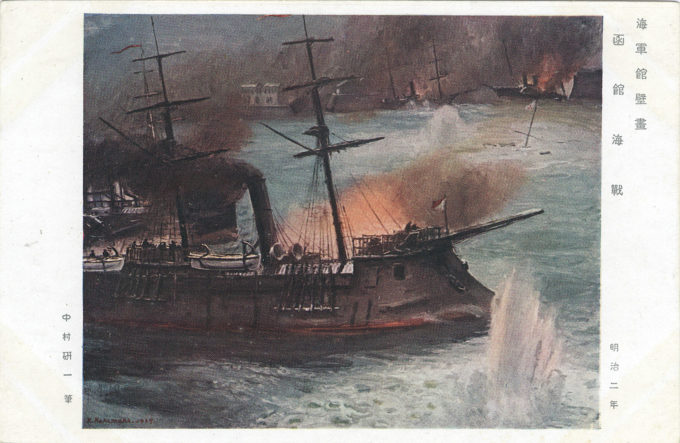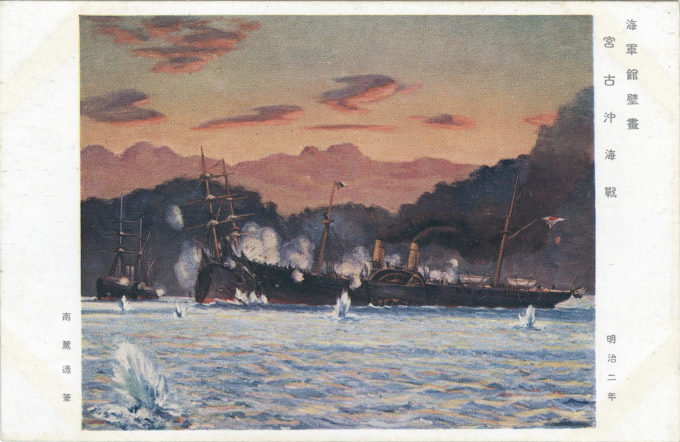The Boshin War, sometimes known as the Japanese Revolution or Japanese Civil War, was fought from 1868 to 1869, marking the final battles between forces of the former Tokugawa shogunate and the clique of rebellious daimyo seeking to seize political power in the name of the Imperial Court.
The Tokugawa bakufu, its policy of self-imposed isolation breached by Cmdr. Perry’s “Black Ships” in 1853, faced growing internal dissent because of the shogunate’s subsequent policy of acquiescing – under threat of force – to foreign demands for open trade and Westernization (the “unequal treaties“).
After an initial battlefield setback, the western domain of Choshu, joined by its allied provinces, Satsuma and Tosa, defeated shogunate forces at the Battle of Toba–Fushimi.
The rebel triumvirate then moved north, progressively taking more control of the rest of Japan from the shogunate until a final stand-off in the northern island of Hokkaidō where the remaining forces of the Tokugawa army and navy had escaped, along with a handful of French military advisers. There, the vice-commander of the Shogun’s navy, Admiral Enomoto Takeaki, had organized a government, with the objective of establishing an independent island nation, the Republic of Ezo.
The naval battles of Miyako Bay and Hakodate, among the first engagements ever in history between modern armored warships, marked the beginning of the end of the last rebel resistance. Admiral Enomoto surrendered his government on June 27, 1869, accepting Emperor Meiji’s rule, and the Ezo Republic ceased to exist, thus ending the Boshin War.
See also:
Graves of the Shogitai, Ueno Park, Tokyo, c. 1930.
Statue of Omura Masujiro at Yasukuni Shrine, Tokyo, c. 1920.

Naval Battle of Hakodate (May 1869), Boshin War commemorative postcard, c. 1930. Foreground: Kosetsu, a modern steam-powered ironclad ram with mounted gunnery, served as the Imperial Japanese Navy’s flagship of a small ad hoc fleet assembled for the operation to land troops at Washinoki Bay north of the rebel capital at Hakodate on peninsular Hokkaido. Although considered technically superior, the Tokugawa navy was routed by the Imperial fleet.
Kosetsu had originally been built in France by a private shipyard for the Confederate States of America (as the Stonewall). It was surreptitiously acquired by the C.S.A. through Danish brokers – because of a 1863 French law banning war matériel sales to the Confederacy – but never saw service before the end of the American Civil War, after which Stonewall was seized as a war prize by the U.S. government and then re-sold to Japan’s Imperial forces in late 1867.
The Naval Battle of Hakodate, May 4-10, 1869
The naval battle of Hakodate was part of an overall battle plan by Imperial forces to land troops at Washinoki Bay to take control of the rebel capital at Hakodate.
Opposing the Imperial army and its supporting naval force was the navy of the Ezo Republic were grouped around the warship Kaiten (the former SMS Danzig paddle corvette of the Prussian Navy). The fleet originally consisted of eight steamships: Kaiten, Banryū (the former HMY Emperor armed schooner, gifted to the Tokugawa shogunate in 1858), Japanese gunboat Chiyoda (Japan’s first domestically produced steam warship), Chōgei (the former ferryboat Danberton, built in Glasglow), Kaiyō Maru (a steam frigate built in the Netherlands), Kanrin Maru (built in the Netherlands), Mikaho (built in the Netherlands) and Shinsoku (the former USS Meteor steam transport, built in the United States).
For the operation, an imperial Japanese fleet had been rapidly constituted around the recently acquired ironclad warship Kōtetsu (the former CSS Stonewall), which had just been purchased from the United States. Other Imperial ships were Kasuga (the former Keangsoo paddle steam warship, originally built for China in Great Britain), Hiryū (a steam transport), Teibō No.1 (built in Great Britain for the Choshu Domain Navy), Yōshun (the former USS Sagamore, a “90-day gunboat” built in the United States during its Civil War), and Mōshun (built in Great Britain for the Saga Domain), which had been supplied by the domains of Saga, Chōshū and Satsuma to the newly formed Meiji government in 1868. In addition, the Imperial government received two transportation ships chartered by the United States for the transportation of its troops.
The Imperial fleet supported the deployment of troops on the island of Hokkaidō, destroyed onshore fortifications and attacked the rebel ships. On 4 May Chiyoda was captured by Imperial forces after having been abandoned in a grounding. On 7 May the rebel’s Kaiten was heavily hit and put out of action. Banryū managed to sink the Imperial forces’ Chōyō, but Banryū later sank in turn because of heavy damage.
The future Admiral of the Fleet, Tōgō Heihachirō, participated in the battle on the Imperial side as a young third-class officer, onboard Kasuga.
The Naval Battle of Miyako Bay, May 6, 1869
Miyako Bay is in present-day Iwate Prefecture, in the northern Tōhoku region of Honshu. The Naval Battle of Miyako Bay was a daring, desperate but ultimately futile attempt by the Republic of Ezo naval forces to interdict and neutralize the Imperial government’s powerful new ironclad, Kōtetsu, before it could arrive to lead the Imperial government’s operation against rebel forces at Hakodate, Hokkaido, more than 200 miles away.
Kōtetsu, later renamed Azuma, was as an armored ram for service in shallow waters, but also carried three mounted Gatling guns. The ship was built to order in Bordeaux, France, for the Confederate States of America navy under the cover name “Sphinx”, but was sold to Denmark after sales of warships by French builders to the Confederacy were forbidden in 1863.
The Danes refused to accept ownership the ship; rather, the Danes quickly resold “Sphinx” to the waiting Confederates which commissioned her as CSS Stonewall in 1865. However, the ship did not reach Confederate waters before the end of the American Civil War in April 1865 and was instead turned over to the United States government as a war prize.
The Tokugawa shogunate of Japan bought Stonewall from the United States in 1867 and renamed her Kōtetsu, but delivery was held up by the Americans – who considered themselves to be a neutral party during the Boshin War – until after the winning Imperial faction had established control over most of the country. Kōtetsu was finally delivered in March 1869 to the new government and was immediately commissioned as the flagship of the embryonic Imperial Japanese Navy.
On 25 March 1869, during the Battle of Miyako Bay, Kōtetsu successfully repulsed a surprise night attempt at naval boarding by the rebel Kaiten, making use of its mounted Gatling guns to repel the attackers.
To create surprise, the rebel squadron had planned use a “false flag” operation, with Kaiten entering Miyako Bay under an American flag, accompanied by the steam warship Takao and armoree schooner Banryū. However, the operation was plagued with problems before reaching its destination. En route, the squadron encountered bad weather during which Takao developed engine trouble. Unable to achieve more than 3 knots due to its engine trouble, Takao trailed far behind when Kaiten began its attack. Banryū became separated from the small squadron and would return to Hokkaidō without participating in the battle.
Kaiten damaged three Imperial warships, but finally disengaged without having captured Kōtetsu. Kaiten steamed out of Miyako Bay, pursued by the Imperial fleet (which had been warming up their engines even before the attack began), just as Takao was entering. Kaiten eventually escaped to Hokkaidō, but Takao was too slow to outdistance its pursuers and was beached at little distance from Miyako Bay and scuttled by explosion as her crew escaped inland.


